| River Battleships:
Soviet Naval Infantry
by Mike Bennighof, Ph.D.
May 2023
 When the Germans launched their surprise attack on the Soviet Union in June 1941 (aided by the Romanians and Finns), they faced 2.6 million soldiers of the Red Army of Workers and Peasants, organized into 166 divisions plus a number of smaller independent units. When the Germans launched their surprise attack on the Soviet Union in June 1941 (aided by the Romanians and Finns), they faced 2.6 million soldiers of the Red Army of Workers and Peasants, organized into 166 divisions plus a number of smaller independent units.
The Axis offensive met with enormous success; even where the Red Army put up successful resistance, it still had to yield ground. Enormous casualties soon eliminated many of the formations that initially met the invasion. The front had to be held, and hastily-organized new divisions, formations transferred from deeper within Soviet territory, and armed workers’ militia all went to the front to stem the Nazi tide. And so did Red Navy sailors.
The Red Navy’s ground forces – the Naval Infantry, sometimes labelled “Red Marines” – makes their first appearance in the Panzer Grenadier series in Panzer Grenadier: River Battleships, where they fight the Romanians in both historical and hypothetical scenarios. They’re elite troops, usually, with good leadership and excellent morale. They usually have a good array of support weapons at their command, too.
Let’s have a look at them.
Infantry
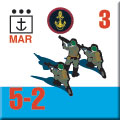 
Just as in a Red Army (RKKA) rifle battalion, the rifle platoon formed the backbone of a Naval Infantry Battalion. A Naval Infantry rifle platoon had, on paper at least, a command group of seven men, including a lieutenant as platoon commander and a sergeant as his assistant, plus one enlisted man as a messenger (who often also served as a sniper). The other four men manned a 50mm mortar; many platoons lacked this weapon and crew.
The rest of the platoon formed three squads, each of 11 men with a squad leader, a two-man light machine-gun team and eight riflemen. Altogether, the platoon had 40 men. In a Naval Infantry platoon, most of the riflemen had SVT40 semi-automatic rifles in contrast to the bolt-action Moisin-Nagant Model 1891 carried by most RKKA foot soldiers. This was an innovative weapon, but difficult to maintain in the hands of poorly educated peasant recruits. Navy recruits usually had at least some formal education and were almost all literate.
An RKKA platoon, on paper at least, had a fourth squad, bringing the total to 51 men. But very few platoons seem to have actually fielded this extra squad, and by 1943 the bureaucracy finally recognized this reality and abolished the fourth squad from the official shtat. The Navy never engaged in the fantasy, and decreed that its platoons would have but three squads.
A Naval Infantry Battalion also fielded a recon platoon armed with sub-machine guns, and manned by the most active and aggressive men selected from the rest of the battalion. They performed special missions and reconnaissance, and also acted as an assault platoon. The RKKA battalion had no equivalent formation. In addition to the recon company, some Naval Infantry Brigades had an additional infantry company armed with sub-machine guns in place of rifles.
For assaults, the Naval Infantry Battalion also had a combat engineer platoon equipped with flamethrowers. Not all battalions had this addition, but when combined with their higher morale and greater infantry firepower, these helped make the Naval Infantry Battalions a favored choice for frontal assaults (and the resulting heavy casualties).
Heavy Weapons
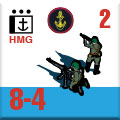 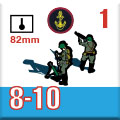 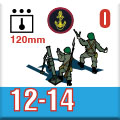
Like the RKKA battalion, a Naval Infantry Battalion had a machine-gun company. The Navy’s version had three platoons, each with four machine guns (usually the same M1910 Maxim on its little wheeled carriage that the RKKA issued). The RKKA company likewise had three platoons, and a platoon of 82mm mortars.
The Naval Infantry Battalion had a company of 82mm mortars, with two platoons of four tubes each. The RKKA battalion likewise had a company of three such platoons at the start of the war, but this was quickly deleted from the shtat and unlike the Naval Infantry it’s doubtful that many battalions had their full allotment of these weapons.
Some Naval Infantry Brigades also had 120mm heavy mortars (at least one such brigade had a full battalion of them, with sixteen tubes). The Model 1938 was a copy of the French Brandt mortar of the same caliber, incorporating some Soviet improvements like a circular base plate (to allow easy traverse without digging out the base plate) and a unique two-wheeled carriage for towing by horse or vehicle. The RKKA issued these as well, at the regimental level.
Anti-Tank

An RKKA rifle battalion included a platoon of 45mm anti-tank guns, at least on paper; few battalions had these after the first weeks of the war and this became official with the new shtat issued in late July 1941. The Model 1937 45mm Sorokapyatka was the standard Soviet light anti-tank gun of the Great Patriotic War, with over 37,000 of them produced. It could not defeat the armor of the larger German tanks, but it did have a good high-explosive round. It would be replaced mid-war by a new gun with a much longer barrel, that had better performance but still could not knock out the biggest German tanks.
Naval Infantry Battalions appear to have kept their anti-tank guns, or even had more of them than an RKKA battalion would have been authorized.
Artillery

An RKKA infantry regiment had a battery of six diminutive 76.2mm short-barreled infantry guns. Naval Infantry Brigades wielded the Model 1902 or Model 1936 76.2mm field gun, a full-sized artillery piece with good anti-tank capability as well as direct fire. The manpower pool from which the naval troops drew included plenty of gunners who could easily adapt to serving land-based artillery.
At least one brigade also fielded the Model 1938 122mm howitzer, a powerful weapon far more capable than the opposing 105mm German piece. While the Red Army had to issue whatever could be dragged of its arsenals, the Navy appears to have had much better access to the newest weapons.
Leadership
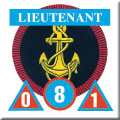
The Naval Infantry had their own small pre-war officer corps, but drew in many of its officers from the Red Navy’s very large coast artillery branch. Others came from sea service along with their men, but adopted the Army ranks used by the Naval Infantry. The Soviet armed forces established combined arms academies in the 1930’s, where naval officers studied ground combat tactics. These men were identified and transferred to the Naval Infantry. Leadership abilities seem to have been generally much greater than those of officers commanding similar RKKA units.
And those are the Naval Infantry pieces of Panzer Grenadier: River Battleships.
You can order River Battleships right here.
Sign up for our newsletter right here. Your info will never be sold or transferred; we'll just use it to update you on new games and new offers.
Mike Bennighof is president of Avalanche Press and holds a doctorate in history from Emory University. A Fulbright Scholar and NASA Journalist in Space finalist, he has published an unknowable number of books, games and articles on historical subjects.
He lives in Birmingham, Alabama with his wife, three children and his dog, Leopold. Leopold knows the number.
Want to keep Daily Content free of third-party ads? You can send us some love (and cash) through this link right here.
|
